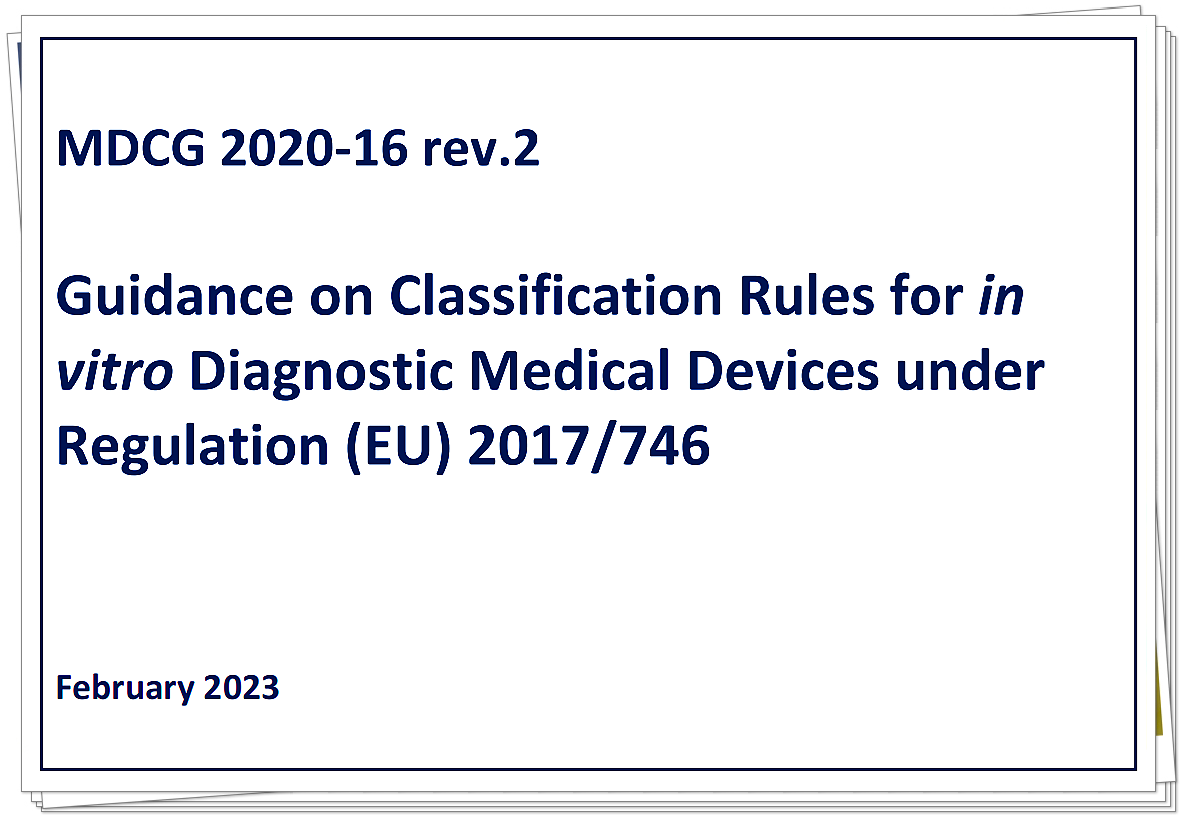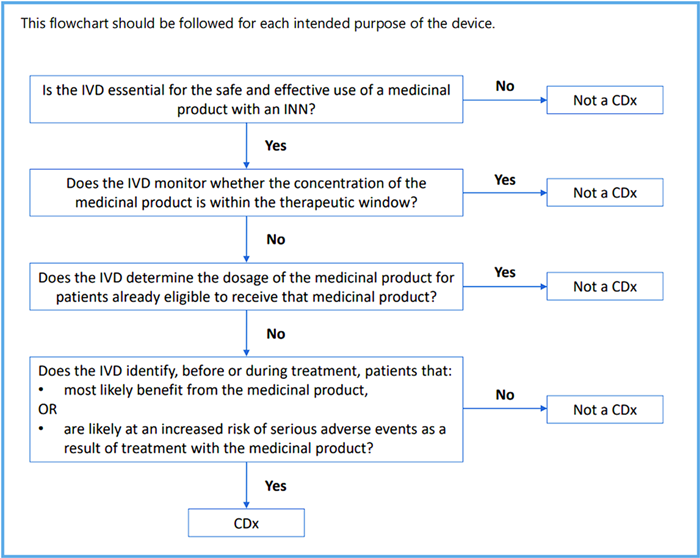一. 概 述
北京时间2023年2月11日,MDCG 2020-16《体外诊断医疗器械分类规则指南》(用于法规(EU)2017/746体外诊断医疗器械)发布第二次更新版本(rev.2)。
本次更新属于轻微修订,主要改动涉及规则1(Rule1)的示例、新增伴随诊断(Companion Diagnostics,CDx)的分类依据和分类路径。本期针对该指南重点更新,作针对性解读。

二. 更新内容
内容1:适用于规则1(Rule1)的示例修订
|
修改前 |
Highly virulent pandemic influenza virus. |
|
修改后 |
Highly virulent influenza virus. |
删除流行二字,将非流行性、高致病性流感病毒也都归为D类产品。
内容2:适用于规则31(Rule3)的一般性意见修订
|
修改前 |
Rule 3 covers a range of devices as reflected in its indents (a)-(m). Devices falling under Rule 3 (when not classified as Class D according to rules 1 & 2) are to be classified in class C,irrespective of the indent applied. It may be possible for a device to fall under more than one Rule 3 indent. Where this is the case, the most appropriate indent should always be applied, based on the intended purpose of the device. |
|
修改后 |
Rule 3 covers a range of devices as reflected in its indents (a)-(m). Devices falling under Rule 3 (when not classified as Class D according to rules 1 & 2) are to be classified in class C, irrespective of the indent applied. It may be possible for a device to fall under more than one Rule 3 indent. |
删除“在此情况下,应始终根据器械的预期用途应用最合适”的词条。
强调:器械预期用途应更清晰、描述准确。
内容3:适用于规则3(f)(Rule3(f))的规则内容修订
|
修改前 |
The identification of patients may comprise a quantitative or qualitative determination of specific markers. Such specific markers can be present in healthy subjects and/or in patients. The emphasis ‘before and/or during treatment’ implies that CDxs may be intended to be applied before a treatment with a corresponding medicinal product is initiated, or during treatment, to identify if (still) the patient is (a) likely to benefit from the corresponding medicinal product or (b) likely to be at increased risk of serious adverse reactions. Devices that are intended to be used for monitoring treatment with a medicinal product in order to ensure that the concentration of relevant substances in the human body is within the therapeutic window are not considered to be CDxs |
|
修改后 |
For a device to be defined as a CDx, there should be a link to a medicinal product with an International Non-proprietary Name (INN) . The identification of patients may comprise a quantitative or qualitative determination of specific markers. Such specific markers can be present in healthy subjects and/or in patients. The emphasis ‘before and/or during treatment’ implies that CDxs may be intended to be applied before a treatment with a corresponding medicinal product is initiated, or during treatment, to identify if (still) the patient is (a) likely to benefit from the corresponding medicinal product or (b) likely to be at increased risk of serious adverse reactions. Devices that are intended to be used for monitoring treatment with a medicinal product in order to ensure that the concentration of relevant substances in the human body is within the therapeutic window are not considered to be CDxs (e.g. devices intended for blood glucose monitoring, devices intended for measurement of cyclosporine concentration in blood, devices intended for measurement of metabolites of a medicinal product). Devices intended to determine quantitative or qualitative specific marker(s) to establish the dosage of a particular medicinal product, for patients that are already eligible to receive that medicinal product, are not considered to be CDxs. For example, devices intended to measure creatinine concentration can be used for estimating kidney function to determine the optimal dosage of medicinal products with renal elimination. Another example is devices identifying CYP2D6 or CYP2C19 genotypes of a patient to determine the appropriate dosage of an already prescribed medication. Annex II to this guidance provides a flowchart to help determine whether an IVD is a CDx. |
新增:对于定义为CDx的器械,应链接到具有国际非专利名称(INN)的药品。
新增:用于确定特定药物剂量的定量或定性特定标志物的器械,对于已具备资格接受该药物的患者,不被视为CDxs。
例如:旨在测量肌酐浓度的器械可用于估计肾功能,以确定具有肾消除功能的药物的最佳剂量;识别患者CYP2D6或CYP2C19基因型,以确定处方药物适当剂量的器械。
新增:附录II提供流程图,帮助确定IVD是否为CDx。
强调:伴随诊断器械的分类依据和分类路径。
伴随诊断为医疗器械,属于体外诊断范畴,能够对相应药物或生物制品的安全性、使用效果等重要信息进行评价。

Q1:对于安全有效地使用具有INN的医疗产品,IVD是否至关重要?
Q2: IVD是否监测药物浓度处于治疗窗口期?
Q3:IVD是否确定已有资格接受该药物的患者的药物剂量?
Q4:IVD是否在治疗前或治疗期间确定患者:最大可能受益于该药物,或使用该药物治疗后发生严重不良事件的风险是否会增加?
Q1不适用的情况下,器械为非伴随诊断器械。
如适用Q1,则继续考虑Q2适用情况,如适用Q1+Q2,器械为非伴随诊断器械。
如适用Q1但不适用Q2,则继续考虑Q3适用情况:
1.如适用Q3情况,器械为非伴随诊断器械;
2.如不适用Q3情况,应继续考虑Q4情况:
2.1 如适用Q1,不适用Q2和Q3,但适用Q4,器械为伴随诊断器械;
2.2 如适用Q1,不适用Q2、Q3、Q4情况,器械为非伴随诊断器械。
三. 观点总结
MDCG 2020-16自发布以来已经历2次修订,足见欧盟对于IVDR的重视程度。
虽然MDR/IVDR延期,为企业减压不少,但根据久顺收到的客户反馈,具备MDR/IVDR资质的产品更受欧洲采购商的青睐,国内部分头部IVD企业也未受延期影响,依然同久顺紧密联系,并已委托久顺启动其产品MDR/IVDR认证事宜。
#IVDR过审,“久”是这么“顺”畅!#
→久顺企管集团 近30年全球合规服务专家,近20年资深欧代,配备IVD国际化专业技术团队,荷兰、英国、美国、中国均设公司,无缝链接欧盟实体信息,为体外诊断企业提供合规高效的全系列IVDR服务:
- 技术文件编写、CE注册取证;
- 合规策略及实施辅导、上市后监督咨询;
- 成功布局欧盟临床试验渠道,提供欧盟临床试验一站式CRO服务:临床方案设计、临床试验方案的撰写;与当地实验室/医院合作,安排客户试验产品合规开展临床试验;收集\整理\分析性能试验原始数据并出具临床试验报告等。









 沪公网安备 31011502005499
沪公网安备 31011502005499